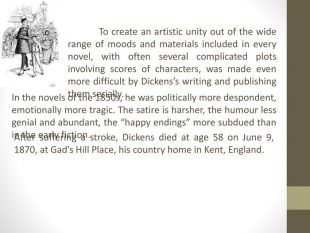Презентація "Charles Dikens"
Про матеріал
Презентація містить матеріал англійською мовою. Матерал може бути використано на уроках англійської мови в старших класах, а також на уроках літератури Англії. Перегляд файлу
Зміст слайдів
pptx
До підручника
Англійська мова (9-й рік навчання, профільний рівень) 10 клас (Несвіт А.М.)
Оцінка розробки


Безкоштовний сертифікат
про публікацію авторської розробки
про публікацію авторської розробки
Щоб отримати, додайте розробку
Додати розробку






















